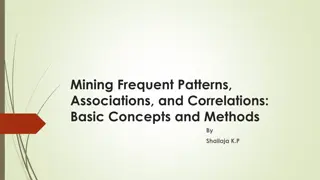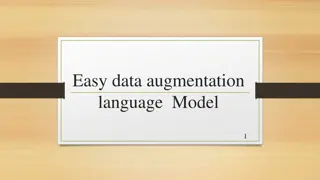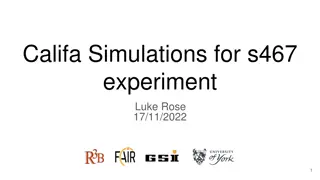Descriptive Data Mining
Descriptive data mining analyzes historical data to find patterns, relationships, and anomalies, aiding in decision-making. Unsupervised learning and examples of techniques like clustering are explored, showcasing the power of data analysis in business.
1 views • 49 slides
Understanding Neural Networks: Models and Approaches in AI
Neural networks play a crucial role in AI with rule-based and machine learning approaches. Rule-based learning involves feeding data and rules to the model for predictions, while machine learning allows the machine to design algorithms based on input data and answers. Common AI models include Regres
11 views • 17 slides
Are Server Rentals Essential for Implementing Clustering?
Discover why renting servers is important for clustering with VRS Technologies LLC's helpful PDF. Learn how to make your IT setup better. For Server Rental Dubai solutions, Contact us at 0555182748.
13 views • 2 slides
Understanding Clustering Algorithms: K-means and Hierarchical Clustering
Explore the concepts of clustering and retrieval in machine learning, focusing on K-means and Hierarchical Clustering algorithms. Learn how clustering assigns labels to data points based on similarities, facilitates data organization without labels, and enables trend discovery and predictions throug
1 views • 48 slides
Understanding Similarity and Dissimilarity Measures in Data Mining
Similarity and dissimilarity measures play a crucial role in various data mining techniques like clustering, nearest neighbor classification, and anomaly detection. These measures help quantify how alike or different data objects are, facilitating efficient data analysis and decision-making processe
1 views • 51 slides
Bioinformatics for Genomics Lecture Series 2022 Overview
Delve into the Genetics and Genome Evolution (GGE) Bioinformatics for Genomics Lecture Series 2022 presented by Sven Bergmann. Explore topics like RNA-seq, differential expression analysis, clustering, gene expression data analysis, epigenetic data analysis, integrative analysis, CHIP-seq, HiC data,
0 views • 36 slides
Understanding Frequent Patterns and Association Rules in Data Mining
Frequent pattern mining involves identifying patterns that occur frequently in a dataset, such as itemsets and sequential patterns. These patterns play a crucial role in extracting associations, correlations, and insights from data, aiding decision-making processes like market basket analysis. Minin
1 views • 95 slides
Understanding Semi-Supervised Learning: Combining Labeled and Unlabeled Data
In semi-supervised learning, we aim to enhance learning quality by leveraging both labeled and unlabeled data, considering the abundance of unlabeled data. This approach, particularly focused on semi-supervised classification, involves making model assumptions such as data clustering, distribution r
1 views • 17 slides
Enhancing Belize's Shrimp Industry Through Clustering Strategies
Belize's shrimp industry is a vital part of its economy, facing challenges in scaling production for exports. Emphasizing quality and identifying competitive advantages are key, along with capitalizing on niche markets and seeking certification. Clustering strategies can help firms collaborate, shar
0 views • 6 slides
Understanding Basic Machine Learning with Python using scikit-learn
Python is an object-oriented programming language essential for data science. Data science involves reasoning and decision-making from data, including machine learning, statistics, algorithms, and big data. The scikit-learn toolkit is a popular choice for machine learning tasks in Python, offering t
0 views • 34 slides
Privacy Considerations in Data Management for Data Science Lecture
This lecture covers topics on privacy in data management for data science, focusing on differential privacy, examples of sanitization methods, strawman definition, blending into a crowd concept, and clustering-based definitions for data privacy. It discusses safe data sanitization, distribution reve
0 views • 23 slides
Text Analytics and Machine Learning System Overview
The course covers a range of topics including clustering, text summarization, named entity recognition, sentiment analysis, and recommender systems. The system architecture involves Kibana logs, user recommendations, storage, preprocessing, and various modules for processing text data. The clusterin
0 views • 54 slides
DNA Data Archival: Solving Read Consensus Using OneJoin Algorithm
DNA data storage presents challenges in archiving digital information efficiently due to the nature of biological media. This article delves into the complexities of DNA data storage, emphasizing the importance of robust archival solutions. The OneJoin algorithm offers a scalable and cross-architect
0 views • 8 slides
Efficient Parameter-free Clustering Using First Neighbor Relations
Clustering is a fundamental pre-Deep Learning Machine Learning method for grouping similar data points. This paper introduces an innovative parameter-free clustering algorithm that eliminates the need for human-assigned parameters, such as the target number of clusters (K). By leveraging first neigh
0 views • 22 slides
Understanding Data Mining and Analytics in Bioinformatics
Data mining in bioinformatics involves descriptive analysis of statistical attributes, creating predictive models, and empirically verifying them. By employing algorithms from various fields, data mining helps in tasks like classification, clustering, association analysis, and regression. The proces
0 views • 14 slides
Machine Learning Techniques: K-Nearest Neighbour, K-fold Cross Validation, and K-Means Clustering
This lecture covers important machine learning techniques such as K-Nearest Neighbour, K-fold Cross Validation, and K-Means Clustering. It delves into the concepts of Nearest Neighbour method, distance measures, similarity measures, dataset classification using the Iris dataset, and practical applic
1 views • 14 slides
Effective Communication and Visualization Techniques for Analyzing Textual Data
Enhance your data analysis skills with effective communication, visualization, presentation, and storytelling techniques. Discover how to analyze textual data through word/phrase frequencies, collocations, and clustering. Explore tools for text processing and natural language processing, such as Exc
0 views • 21 slides
Understanding Winery Clustering in Washington State: Factors and Implications
Explore the phenomenon of winery clustering in Washington State, examining factors such as natural advantages, collective reputation, and demand-side drivers. Discover why wineries in the region tend to locate close to each other and the impact on cost advantage and industry dynamics.
0 views • 18 slides
Understanding Data Structures in High-Dimensional Space
Explore the concept of clustering data points in high-dimensional spaces with distance measures like Euclidean, Cosine, Jaccard, and edit distance. Discover the challenges of clustering in dimensions beyond 2 and the importance of similarity in grouping objects. Dive into applications such as catalo
0 views • 55 slides
Understanding K-means Clustering for Image Segmentation
Dive into the world of K-means clustering for pixel-wise image segmentation in the RGB color space. Learn the steps involved, from making copies of the original image to initializing cluster centers and finding the closest cluster for each pixel based on color distances. Explore different seeding me
0 views • 21 slides
Understanding Transitivity and Clustering Coefficient in Social Networks
Transitivity in math relations signifies a chain of connectedness where the friend of a friend might likely be one's friend, particularly in social network analysis. The clustering coefficient measures the likelihood of interconnected nodes and their relationships in a network, highlighting the stru
0 views • 8 slides
Trajectory Data Mining: Overview and Applications
Spatial trajectories represent moving objects in geographical spaces with examples from human mobility, transportation vehicles, animals, and natural phenomena. Sources of trajectory data include human mobility records, active/passive recordings, and sensor data. The paradigm of trajectory data mini
0 views • 8 slides
Semantically Similar Relation Clustering with Tripartite Graph
This research discusses a Constrained Information-Theoretic Tripartite Graph Clustering approach to identify semantically similar relations. Utilizing must-link and cannot-link constraints, the model clusters relations for applications in knowledge base completion, information extraction, and knowle
0 views • 14 slides
Density-Based Clustering Methods Overview
Density-based clustering methods focus on clustering based on density criteria to discover clusters of arbitrary shape while handling noise efficiently. Major features include the ability to work with one scan, require density estimation parameters, and handle clusters of any shape. Notable studies
0 views • 35 slides
Analysis of Particle Clustering and Reconstruction Methods in Binsong, MA
This weekly report delves into the detailed examination of dEdx in PID, charged particle clustering in the Lcal region, neutral particle reconstruction, and methods involving the Clupatra Track collection and TPCTrackerHits collection. The report showcases the processes, methods, and results related
0 views • 7 slides
Understanding Clustering Methods for Data Analysis
Clustering methods play a crucial role in data analysis by grouping data points based on similarities. The quality of clustering results depends on similarity measures, implementation, and the method's ability to uncover patterns. Distance functions, cluster quality evaluation, and different approac
0 views • 8 slides
Understanding Text Vectorization and Clustering in Machine Learning
Explore the process of representing text as numerical vectors using approaches like Bag of Words and Latent Semantic Analysis for quantifying text similarity. Dive into clustering methods like k-means clustering and stream clustering to group data points based on similarity patterns. Learn about app
0 views • 25 slides
Achieving Demographic Fairness in Clustering: Balancing Impact and Equality
This content discusses the importance of demographic fairness and balance in clustering algorithms, drawing inspiration from legal cases like Griggs vs. Duke Power Co. The focus is on mitigating disparate impact and ensuring proportional representation of protected groups in clustering processes. Th
0 views • 36 slides
Building Our Own Virtualized Infrastructure with Hyper-V
Learn how to set up a virtualized infrastructure using Hyper-V, including deploying Windows Server 2019, configuring Active Directory, setting up Failover Clustering, and managing Hyper-V Core servers. The guide covers network setup, domain controller promotion, clustering setups, iSCSI configuratio
0 views • 10 slides
Unsupervised Multiword Expression Extraction Using Measure Clustering Approach
Goal of this study is to develop an unsupervised method for extracting multiword expressions (MWEs) like idioms, terms, and proper names of different semantic types. The research focuses on properties of MWEs, data analysis, statistical measures, and clustering results to supplement lexical resource
0 views • 44 slides
Understanding Clustering Algorithms in Data Science
This content discusses clustering algorithms such as K-Means, K-Medoids, and Hierarchical Clustering. It explains the concepts, methods, and applications of partitioning and clustering objects in a dataset for data analysis. The text covers techniques like PAM (Partitioning Around Medoids) and AGNES
0 views • 74 slides
Understanding Major Terms, Cluster Labels, and Themes in IN-SPIRE Training
Major terms in IN-SPIRE are keywords used for clustering documents, while cluster labels in Galaxy view represent the most important terms associated with a point. Themes, calculated by clustering keywords, provide a higher-level description of data. PNNL techniques like RAKE and CAST help extract a
0 views • 4 slides
Understanding Corporate Climate Assessment Using NLP Clustering
This work explores a novel approach in corporate climate assessment through applied NLP clustering, highlighting the relationship between climate risk and financial implications. The use of advanced techniques like BERT embedding for topic representation and clustering in corporate reports is discus
0 views • 33 slides
Easy Data Augmentation for Language Models
Data augmentation plays a crucial role in enhancing model performance, especially for tasks like sentiment analysis, topic labeling, and language detection. By generating more training data and reducing overfitting, techniques like Synonym Replacement, Random Insertion, Random Swap, and Random Delet
0 views • 12 slides
Correlation Clustering: Near-Optimal LP Rounding and Approximation Algorithms
Explore correlation clustering, a powerful clustering method using qualitative similarities. Learn about LP rounding techniques, approximation algorithms, NP-hardness, and practical applications like document deduplication. Discover insights from leading researchers and tutorials on theory and pract
0 views • 27 slides
Clustering Sources and Services for ITS Data Sharing in Brussels
Andrea Detti and Lorenzo Bracciale from CNIT, University of Rome Tor Vergata, discuss clustering projects for Intelligent Transportation System (ITS) data and services in Brussels. The presentation covers the problem, solutions, consumer and producer guidance, and contact information for further inq
0 views • 13 slides
Exploring Avatar Path Clustering in Networked Virtual Environments
Explore the concept of Avatar Path Clustering in Networked Virtual Environments where users with similar behaviors lead to comparable avatar paths. This study aims to group similar paths and identify representative paths, essential in analyzing user interactions in virtual worlds. Discover related w
0 views • 31 slides
Understanding Social and Spatial Clustering of Personal Relationships in STI Transmission
Exploring the impact of behavioral risks on the transmission of sexually transmitted infections (STIs) through social and spatial clustering of personal relationships. The rise in STIs globally and in Canada is highlighted, emphasizing transmission methods, efficiency rates, and populations at risk.
0 views • 27 slides
Califa Simulations and Experimental Observations in Nuclear Physics Research
Exploring nuclear physics research through Califa simulations and experimental observations with a focus on PID gating, clustering algorithms, beam settings, and Ca isotopes chain gating. The study involves simulating events on CH2 targets, analyzing clustering effects, and observing opening angles
0 views • 10 slides
Implementation of InfoGAN Neural Network for Breast Cancer Cell Clustering
Julia implementation of InfoGAN neural network for semi-supervised clustering of breast cancer cells. The project aims to address diagnostic bottlenecks in low-resource settings by utilizing digital holography for molecular data acquisition. By analyzing key hormone and growth factor receptors on br
0 views • 19 slides






































